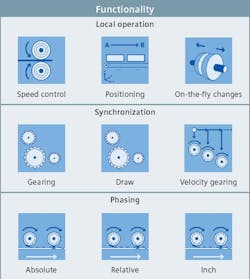Designers of packaging machines and other motion-intensive equipment have to sort through a lot of technology—motors, drives, control systems—to find the right solution to their application needs, even as the technology evolves. One of Automation World’s most well-read articles in 2013, for example, was a practical guide to choosing between pneumatic and electric actuators. http://www.automationworld.com/industry-business/your-top-10-automation-world-stories-2013
In the world of motion applications, the use of mechanical line shafts may be declining as their electronic counterparts come up, but machine builders still must address vibration, torsion elasticity and gear backlash no matter which route they take. Information on two very different resources crossed my desk recently, which might be of interest to builders of machines.
When it comes to mechanical line shafts, elastomer couplings—also known as spider or jaw couplings—are being used to damp rotational movement especially in areas where vibration or impact loads are expected.
Elastomer couplings connect the driving and driven shafts and transmit rotary power across the insert between them. They can compensate for shaft misalignment while also adding a damping effect to the driveline. A new technical paper from R+W America covers sizing, selection and how elastomer materials are available in various hardness levels, measured on the Shore hardness scale.
Precision coupling inserts, which are normally made of thermoplastic polyurethane (TPU) or HYTREL material, reduce and compensates for torque impacts. They also damp vibration between the driving and driven shafts, and can serve to filter it out, which allows the entire drive system to run more smoothly. The various hardness levels of the material compensate for the various torque impacts and vibration in specific applications.
Elastomer jaw couplings are normally sized according to the DIN 740 guidelines, and R+W also offers a Microsoft Excel based sizing program to help.
On the other end of the spectrum, Siemens Industry announced the availability of a Simotion Synchronized Drive Control (SDC) standard application solution for printing and converting. With electronic line shafts, torsion elasticity and gear backlash are eliminated by electronically gearing individual sections together. Synchronized Drive Control technology is an open source application customizable for a printing line or converting machine’s specific requirements. For example, to maximize the make-ready and uptime efficiencies of the line, it is often necessary to electronically decouple line sections for plate changes on the fly. This control system combines with modern drives, drive controls and electronic feedback devices to make it possible to synchronize all drive sections and streamline the process.
Simotion SDC can synchronize all motion functionality between multiple Simotion motion controllers over a Profinet network, allowing 100 or more axes to be engaged on the system architecture simultaneously or grouped, as needed. The system handles synchronization using Siemens Virtual Master technology. Axes on a single or multiple Simotion controller arrangement can be geared together in a common Virtual Master, then operated in a Global Master mode when all axes are in operation, or a Local Master, when only sections of the line are running. Operation with multiple Global Master and Local Master modes is also possible.
Simotion SDC can be applied to gravure, offset, flexo and digital printing presses in wide, mid-range and narrow web format, as well as to other finishing equipment including binders, stitchers, inserters, collators, polywraps, conveyors, grippers and stackers. Siemens application specialists are available to advise and consult.
About the Author
Renee Bassett
Managing Editor

Leaders relevant to this article:
